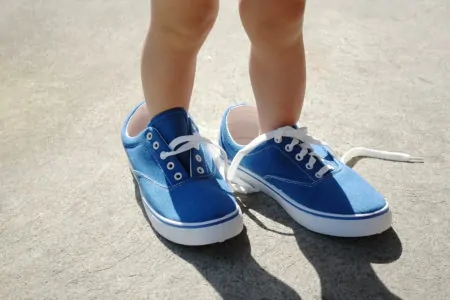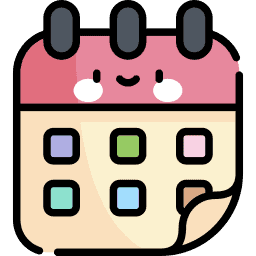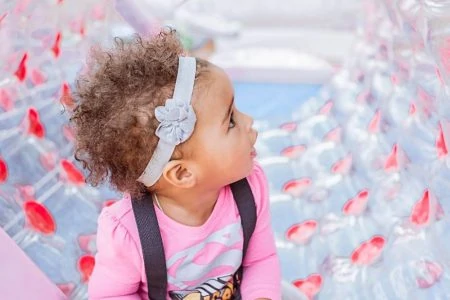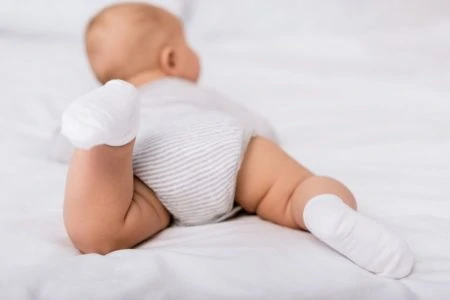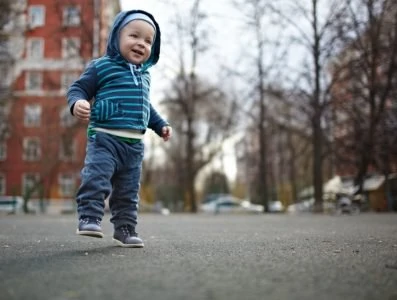You blink, and suddenly their toes are crunching against the front of their sneakers. Finding the right fit is about more than avoiding trips; it is about ensuring healthy foot development for your growing child.
We know the struggle of buying shoes that fit perfectly today only to be too tight next month. To help you navigate the chaos of growth spurts, we consulted experts to create accurate size charts and easy measurement methods. Here is everything you need to know to find that Cinderella fit.
Key Takeaways
- Measure frequently: Check your child’s foot size every two months until age 4, then every four to six months.
- Prioritize function: Look for breathable materials, flexible soles, and wide toe boxes rather than just style.
- Fit for the larger foot: Most people have one foot slightly larger than the other; always size the shoes to the bigger foot.
- Room to grow: Ensure there is about a thumb’s width of space between the longest toe and the end of the shoe.
Baby Shoe Size Chart (0 to 12 Months)
| U.S. | Euro | U.K. | Inches | CM |
|---|---|---|---|---|
| 0.5 | 16 | 0 | 3.25 inches | 8.3 centimeters |
| 1 | 16 | 0.5 | 3.5 inches | 8.9 centimeters |
| 1.5 | 17 | 1 | 3.625 inches | 9.2 centimeters |
| 2 | 17 | 1 | 3.75 inches | 9.5 centimeters |
| 2.5 | 18 | 1.5 | 4 inches | 10.2 centimeters |
| 3 | 18 | 2 | 4.125 inches | 10.5 centimeters |
| 3.5 | 19 | 2.5 | 4.25 inches | 10.8 centimeters |
| 4 | 19 | 3 | 4.5 inches | 11.4 centimeters |
| 4.5 | 20 | 3.5 | 3.625 inches | 11.7 centimeters |
| 5 | 20 | 4 | 4.75 inches | 12.1 centimeters |
Toddler Shoe Size Chart (1 to 5 Years)
| U.S. | Euro | U.K. | Inches | CM |
|---|---|---|---|---|
| 5.5 | 21 | 4.5 | 5 inches | 12.7 centimeters |
| 6 | 22 | 5 | 5.125 inches | 13 centimeters |
| 6.5 | 22 | 5.5 | 5.25 inches | 13.3 centimeters |
| 7 | 23 | 6 | 5.5 inches | 14 centimeters |
| 7.5 | 23 | 6.5 | 5.625 inches | 14.3 centimeters |
| 8 | 24 | 7 | 5.75 inches | 14.6 centimeters |
| 8.5 | 25 | 7.5 | 6 inches | 15.2 centimeters |
| 9 | 25 | 8 | 6.125 inches | 15.6 centimeters |
| 9.5 | 26 | 8.5 | 6.25 inches | 15.9 centimeters |
| 10 | 27 | 9 | 6.5 inches | 16.5 centimeters |
| 10.5 | 27 | 9.5 | 6.625 inches | 16.8 centimeters |
| 11 | 28 | 10 | 6.75 inches | 17.1 centimeters |
| 11.5 | 29 | 10.5 | 7 inches | 17.8 centimeters |
| 12 | 30 | 11 | 7.125 inches | 18.1 centimeters |
Kids Shoe Size Chart (6 to 10 Years)
| U.S. | Euro | U.K. | Inches | CM |
|---|---|---|---|---|
| 12.5 | 30 | 11.5 | 7.25 inches | 18.4 centimeters |
| 13 | 31 | 12 | 7.5 inches | 19.1 centimeters |
| 13.5 | 31 | 12.5 | 7.625 inches | 19.4 centimeters |
| 1 | 32 | 13 | 7.75 inches | 19.7 centimeters |
| 1.5 | 33 | 14 | 8 inches | 20.3 centimeters |
| 2 | 33 | 1 | 8.125 inches | 20.6 centimeters |
| 2.5 | 34 | 1.5 | 8.25 inches | 21 centimeters |
| 3 | 34 | 2 | 8.5 inches | 21.6 centimeters |
| 3.5 | 35 | 2.5 | 8.625 inches | 21.9 centimeters |
| 4 | 36 | 3 | 8.75 inches | 22.2 centimeters |
| 4.5 | 36 | 3.5 | 9 inches | 22.9 centimeters |
| 5 | 37 | 4 | 9.125 inches | 23.2 centimeters |
| 5.5 | 37 | 4.5 | 9.25 inches | 23.5 centimeters |
| 6 | 38 | 5 | 9.5 inches | 24.1 centimeters |
| 6.5 | 38 | 5.5 | 9.625 inches | 24.4 centimeters |
| 7 | 39 | 6 | 9.75 inches | 24.8 centimeters |
How to Measure Your Child’s Feet
You do not need a professional fitting every time your child hits a growth spurt. Measuring at home is simple with a few basic tools. Here are three reliable methods to get the right number.
1. Tracing Method
Tracing is a classic method that requires zero special equipment. It is best done in the afternoon when feet are slightly swollen from the day’s activity.
Gather these supplies:
- Paper: A blank sheet larger than their foot.
- Writing tool: A pen or marker.
- Measuring tool: A ruler or tape measure.
- Flat surface: A hard floor (avoid carpet).
Remember Both Feet
Follow these steps:
- Trace the outline: Place the paper on a hard floor. Have your child stand on it with their back straight. Trace around the foot, keeping the pen upright and perpendicular to the paper to avoid adding or subtracting size.
- Measure the length: Step off the paper. Use your ruler to measure the distance from the very back of the heel to the tip of the longest toe. Write this down.
- Measure the width: Measure the widest part of the footprint, which is usually across the ball of the foot.
- Find the size: Compare your length and width measurements to the charts above to determine the correct size.
2. Printable Guide
Many brands like Stride Rite provide printable sizing charts. These are convenient, but you must ensure your printer settings are correct.
Here is what you need:
- The guide: Download a sizing chart (like this one).
- Tape: To secure the paper to the floor.
- Wall: A flat vertical surface.
- Credit card: Often used to verify the scale of the print.
How to do it:
- Check the scale: Before measuring, place a credit card or ruler against the scale check box on the paper. If it doesn’t match perfectly, reprint at 100% scale.
- Align the paper: Tape the paper to the floor so the curved heel line is flush against a wall.
- Measure length: Have your child stand on the paper with their heel against the wall. Mark the line that touches the tip of their longest toe.
- Check width: most printable guides have a “width bar.” Align the foot properly and mark the width to see if your child needs wide or extra-wide shoes.
3. Use a Shoe Size Gauge
If you buy shoes online frequently, investing in a Brannock device or a simple plastic foot gauge can save time.
Here is the process:
- Position the device: Place the gauge on a flat surface. Open the slider all the way.
- Place the foot: Have your child place their heel firmly in the heel cup. Ensure they are standing with weight distributed evenly.
- Slide to measure: Move the slider until it lightly touches the longest toe. Read the size indicated.
- Check width: If the device has a width slider, slide it to the side of the foot to determine the letter width (e.g., M for Medium, W for Wide).
How Often to Size Your Kid’s Feet
Tiny feet grow at lightning speed. Between the ages of 2 and 6, a child’s foot can grow up to half a size every two to four months. Experts recommend measuring your child’s feet every two months until they turn 4 (1).
After their fourth birthday, growth slows slightly. You can switch to checking their size every four to six months. However, always pay attention to complaints about foot pain or tripping, as these are signs of a sudden growth spurt.
When Your Child Is Between Sizes
It is rare for a foot to measure exactly to a whole or half size. If your child falls between sizes, always size up.
A shoe that is slightly roomy allows for growth and movement. Conversely, footwear that is too snug can restrict development, cause blisters, and lead to ingrown toenails or foot deformities (2).
Shoe Buying Tips by Age
1. Tips for Babies (0-2 Years)
Babies do not need shoes until they start walking outdoors. In fact, barefoot is best for developing arch strength and coordination (3). Once they take those first steps, focus on protection and flexibility.
Don't Rush
- Material matters: Choose soft leather, canvas, or cloth. Avoid stiff synthetics that do not breathe.
- The bend test: Take the shoe and try to fold it in half. It should bend easily. If it is stiff, it will hinder your new walker’s natural movement.
- Shop late: Feet swell throughout the day. Try shoes on in the afternoon to ensure they won’t be too tight by dinnertime.
- Check the heel: You should be able to slide your pinky finger between the heel of the shoe and your baby’s foot. If you can’t, it is too tight.
2. Tips for Toddlers (2-5 Years)
Toddlers run, jump, and crash into things. They need durability, but their feet are still developing cartilage and muscle.
- Bring the right socks: If they will wear the shoes with thick winter socks, bring a pair to the store. Measuring with thin liners can lead to a tight fit later.
- Skip the gimmicks: High heels, heavy clogs, or stiff cowboy boots might look cute, but they are tripping hazards. Stick to flat, grippy soles.
- Look for Velcro: Hook-and-loop closures foster independence. Toddlers love putting on their own shoes, and it saves you from tying laces ten times a day.
- Check the toe box: Toddler feet are often triangular, narrow at the heel and wide at the toes. Look for shoes with a rounded, wide toe box to prevent squishing.
3. Tips for Older Kids (6+ Years)
As kids get older, they care more about style, but fit is still king.
- Watch them walk: Have your child walk (and run) around the store. Watch for heel slippage or awkward gait changes.
- The thumb test: Press your thumb down sideways between the end of the shoe and their big toe. You should feel about a thumb’s width of space.
- Ask specific questions: Instead of “do these fit?”, ask “does your pinky toe touch the side?” or “does the heel rub when you jump?”.
